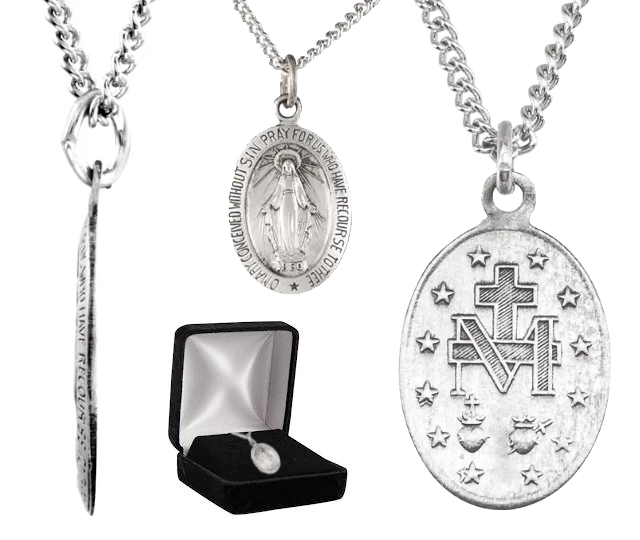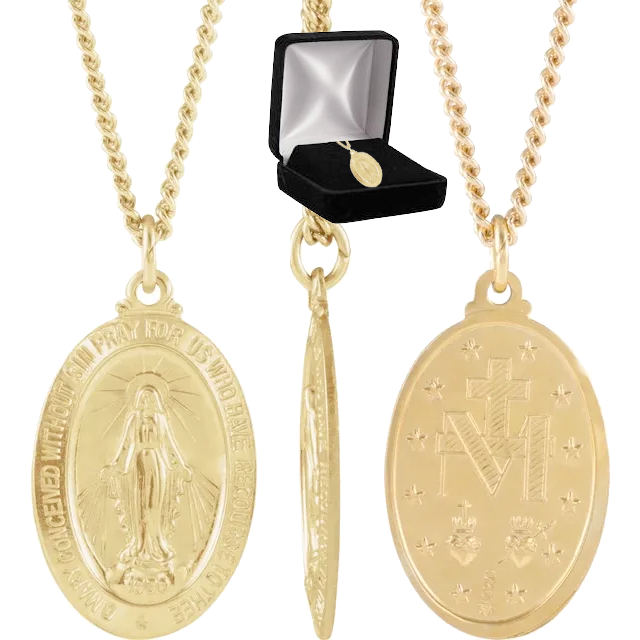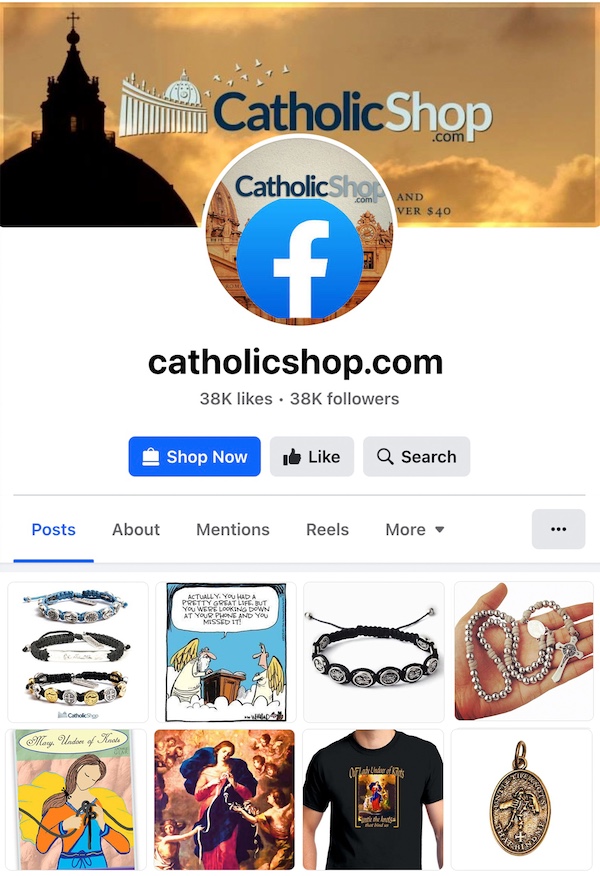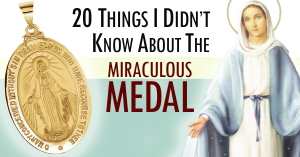
I’ve worn a Miraculous Medal for more than 15 years.
I wear it religiously, pun intended.
If you’re not of the Catholic persuasion, you might be thinking “Why?”
And if you’re a 7 year old boy who is not of the Catholic persuasion, you might be thinking “Why do you wear a medal with a GIRL on it!?”
Well, dear theoretical 7-year-old boy, I don’t wear it for the way it looks – although I do think it looks pretty cool, especially because of the girl on it.

And, my little imaginary frenemy, I don’t wear it out of habit – and, speaking of habits, I’ll soon tell you about an extraordinary young woman who wore a habit wider than her shoulder span.
The truth is, I wear a Miraculous Medal because I believe in its promises.
How can I not? After all, the Miraculous Medal is at least partially responsible for leading me back to the Church when I was 21 years old.
You see, although my parents baptized me as an infant, they divorced when I was young and I grew up without religion. I had some belief, sure, but I also had plenty of doubts.
Yes, I was once that 7-year-old boy who would have questioned a man wearing a medal with a girl on it.
And Catholicism? Not a chance. I ran from the Church, fueled by misconceptions.
Eventually, though, the Church caught up with me and, well, tackled me to the ground.
When I was 20 years old, my grandfather – one of the few practicing Catholics left in our family – began telling me about Marian apparitions. As I listened with both curiosity and skepticism, he suddenly stopped mid-sentence and removed a gold chain from around his neck.
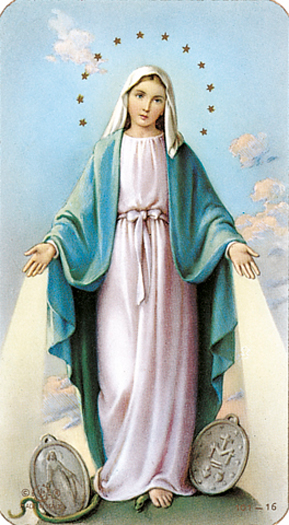 “I’ve had this since I was young,” he said, placing it in my hand. “I want you to have it.”
“I’ve had this since I was young,” he said, placing it in my hand. “I want you to have it.”
He wasn’t talking about his gold chain, though. Attached to it was a gold Miraculous Medal. I didn’t know what to say, but thank you wasn’t the first thing that came to mind. It certainly didn’t seem like something I’d ever wear. Especially not in public.
I turned the medal around in my hand. The shiny face of the Virgin Mary gazed up at me with a blank stare as if to ask, “Well, Sean, are you going to humor your dear Grandpa or do you want to make him sad?”
I put the chain around my neck and thanked my grandfather, and then we went our separate ways. I forgot about it until I got back to college that night.
I decided that I would put the medal in my desk drawer and try to remember to wear it the next time I visited my grandparents. Every time I started to take the necklace off, however, I felt guilty, as if I was doing something wrong. When I finally did manage to take it off, I had a sense that part of me was missing.
So, I simply started wearing the medal every day (under my shirt, of course). Almost immediately, a series of personal events began to unfold that altered the course of my life and turned me into a believer, a Catholic, and, in the eyes of my friends at that time, the Blessed Mother’s #1 fanboy.
I’ve been wearing the same Miraculous Medal ever since. It’s been a source of consolation in times of worry, and a light in the darkness when I’ve been lost.
The Church celebrates the Feast of Our Lady of the Miraculous Medal every November 27. The following day, November 28, is the Feast of St. Catherine Labouré, the French nun who experienced the Marian apparitions from which the Miraculous Medal originated.
Recently, after seeing these feast days on my calendar (yes, my Catholic calendar), I set out to learn more about this life-changing medal that’s been dangling around my neck for all these years. I was so amazed by what I discovered that I wanted to share it with you.
So, here are the 20 Things I Didn’t Know About The Miraculous Medal…
Catherine Laboure’s family did not call her Catherine
 Catherine Laboure was born on May 2, 1806, in the village of Fain-Les-Moutiers, located in the Burgundy region of France. Catherine, the second born daughter, was one of 11 living children.
Catherine Laboure was born on May 2, 1806, in the village of Fain-Les-Moutiers, located in the Burgundy region of France. Catherine, the second born daughter, was one of 11 living children.
Catherine’s birthday, May 2, falls on the feast day of Sts. Exsuperius and Zoe, so from a young age everyone called her Zoe. According to Catholic tradition, St. Zoe and her husband Exsuperius, also known as Hesperus, were Christian slaves who were tortured and killed when they refused to eat food that their master had offered to the gods.
Catherine was born in the month of Mary
For centuries, the Catholic Church has set aside the entire month of May to honor Mary, Mother of God. And, later in her life, Catherine foretold that a time would come when all the world would honor the month of Mary. More on that later.
Catherine Laboure lost her mother at an early age
According to the excellent book Saints Who Saw Mary by Rafael Brown, Catherine’s mother often used to tell her, “In our sorrows, we must always run to Mary – she never turns away from a child who loves her.”
When Catherine was 9 years old, her mother passed away. Although it was heartbreaking for Catherine, she found solace and strength in her faith.
“Dear Blessed Mother,” Catherine declared, “now you will be my mother.”
Pope John Paul II, who had a similarly strong devotion to the Blessed Mother, was also only 9 years old when his mother died.
Catherine experienced mystical visions from an early age
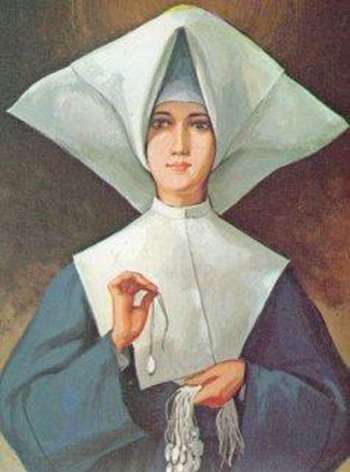
One day, young Catherine was in the village church of Fain-Les-Moutiers when she experienced one of her first mystical experience.
In her vision, she saw an elderly priest celebrating Mass. The old priest beckoned her, but she drew backwards, never taking her eyes off him. Suddenly Catherine found herself in what looked to be an infirmary. The same priest was there. He looked at her and said, “My child, it is a good idea to care for the sick. You run away from me now, but one day you will gladly come to me. God has designs for you. Do not forget that.”
She prayed to understand the meaning behind her vision.
Catherine’s father did not want her to enter the religious life
After Catherine received her First Holy Communion at the age of 12, she had a deep desire to pursue a vocation in religious life. Her older sister, Marie Louise Laboure, had recently joined the Daughters of Charity.
When Catherine was a young woman, her father introduced her to a number of suitors and urged her to marry. “I shall never marry,” she told him. “I have promised my life to Jesus Christ.”
When Catherine was 22, she asked her father’s permission to follow in her sister’s footsteps. Her father, however, refused and sent her to work in her brother’s coffee shop in Paris. Although she was a country girl who had never learned to read or write, Catherine never wavered in her faith and remained determined to enter the religious life.
When Catherine was 24, she visited a hospital run by the Daughters of Charity and was startled to see a painting on the wall of a man who looked exactly like the elderly priest in her vision.
She asked a nun about the painting, and the nun replied, “That’s our founder, Saint Vincent de Paul.”
Shortly after, Catherine’s father changed his mind and granted her permission to follow her dream. She entered religious life on January 22, 1830 at the Hospice de la Charite in Chatillon-sur-Seine. Her postulancy lasted three months, after which she was sent to live at the mother house of the Daughters of Charity of Saint Vincent de Paul at 140 Rue du Bac in Paris.
Catherine once saw St. Vincent de Paul’s heart
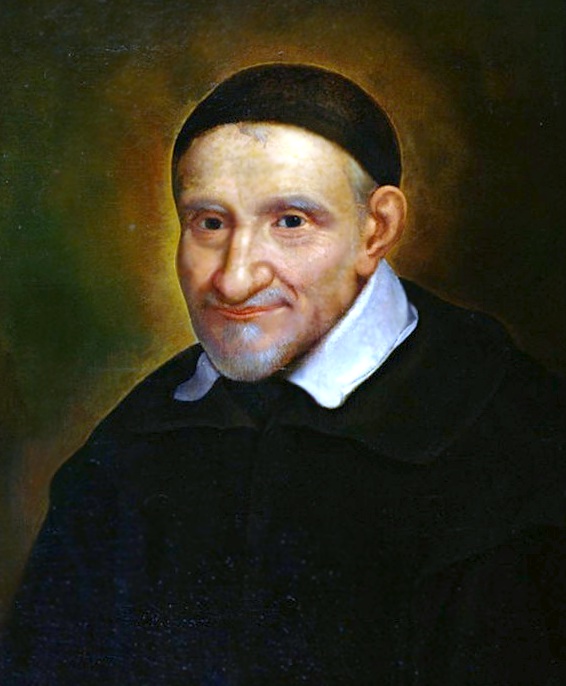 St. Vincent de Paul, who lived from 1581 to 1660, was a French priest who dedicated himself to helping the poor and sick. He founded the Daughters of Charity with a widow named Louise de Marillac, who was also declared a saint.
St. Vincent de Paul, who lived from 1581 to 1660, was a French priest who dedicated himself to helping the poor and sick. He founded the Daughters of Charity with a widow named Louise de Marillac, who was also declared a saint.
In April, 1830, when St. Vincent de Paul’s remains were transferred to the church dedicated to him in Paris, the Daughters of Charity took part in processions and prayers in honor of their founder. For three nights in a row, Catherine experienced visions of what she believed to be St. Vincent de Paul’s heart. When she told the convent chaplain about her vision, however, he instructed her to forget what she had seen and not speak about it.
Catherine had prayed to see Our Lady before the first apparition
On July 18, 1830, the eve of St. Vincent de Paul’s feast day, Catherine prayed that St. Vincent might intercede for her in asking God to grant her a special favor.
“I went to bed with the thought that this night I would see my Good Mother,” Catherine wrote. “I had been wanting to see her for so long! At last I feel asleep with the thought that St. Vincent would obtain for me the grace of seeing the Blessed Virgin.”
Catherine believes she met her guardian angel
It seems that St. Vincent heard Catherine’s prayer that night.
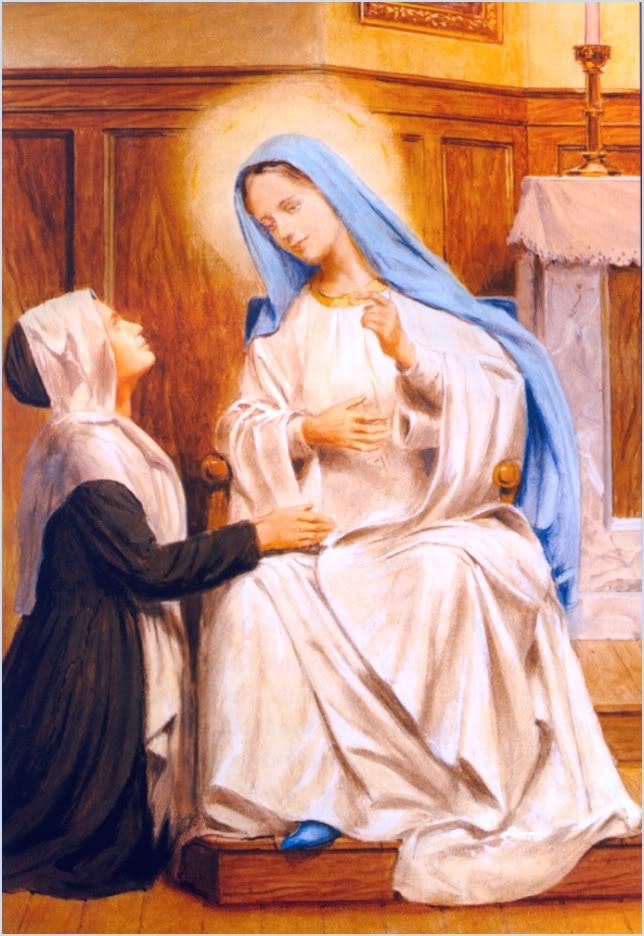 Catherine explained what happened next in her own words: “At half-past at eleven at night, I heard myself being called by name. Waking up, I drew back the curtain and saw a child dressed in white, about four or five years old, who said to me ‘Come to the chapel. Get right up and come to the chapel. The Blessed Virgin is waiting for you!'”
Catherine explained what happened next in her own words: “At half-past at eleven at night, I heard myself being called by name. Waking up, I drew back the curtain and saw a child dressed in white, about four or five years old, who said to me ‘Come to the chapel. Get right up and come to the chapel. The Blessed Virgin is waiting for you!'”
The “child dressed in white,” said Catherine, was a little boy with blue eyes and golden hair. Later, she guessed that he might have been her guardian angel.
The child led Catherine into the chapel, where she was surprised to find all the candles lit as if it was Midnight Mass. But the chapel was empty.
Catherine then described hearing a noise “like the rustling of a silk dress” coming from an unseen source which seemed to move from near a picture of St. Joseph across the chapel to the altar steps. Suddenly, Catherine saw the Blessed Mother appear there. “I sprang forward with one leap to her side – kneeling on the altar steps with my hands resting on the knees of the Blessed Virgin. There I spent the sweetest moment in my life.”
Catherine’s visions included prophecies and future events
Mary told Catherine that God had a special job for her to do, and also warned of a great time of upheaval that would occur in France and beyond.
“My child,” said the Blessed Virgin, “times are very bad. Calamities are going to fall upon France. The whole world will be in an upheavel due to all sorts of troubles.”
And, according to Catherine, Our Lady was very sad when she said these things. But the Blessed Virgin also told Catherine, “My child, the good God wishes to give you a mission. Later I shall let you know what it is. You will have much to suffer. But do not be afraid.”
Later, Catherine asked Our Lady the meaning of what had been shown to her.
“My child,” she answered, “the times are evil, and misfortunes are about to overwhelm France. The throne will be destroyed and the whole world convulsed by all sorts of calamities. But come to the foot of this altar. Here graces will be poured out on all who ask for them, great or small…My eyes are always watching you, I shall grant you many graces. Special graces will be given to all who ask for them, but people must pray.”
Catherine’s visions were rife with symbolism
When Our Lady appeared for the second time on November 27, 1830, Catherine described seeing something like two “living paintings.” In this vision, Our Lady stood on a half-globe with her feet crushing a serpent.
As Mary lifted a small, golden globe topped with a cross toward heaven, Catherine heard her say, “This globe represents the entire world, including France, and every person.”
Our Lady wore jewelry during the second apparition
The second “living painting” that Catherine saw on November 27, 1830 was even more striking. In the vision, reported Catherine, beautiful rays of light streamed from Mary’s hands, emanating from jewels on the rings adorning her fingers.
Some of the jewels on Our Lady’s rings, however, were not shining.
“These rays symbolize the graces I shed upon those who ask for them,” Our Lady told Catherine. “The gems from which rays do not fall are the graces for which souls forget to ask.”
Our Lady promised something very special to those who wear the medal
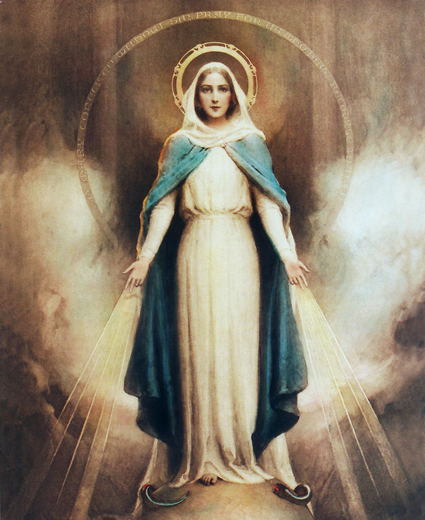 After the Blessed Virgin explained what the rays of light symbolized, Catherine watched with wonder as an oval formed around Our Lady, followed by words which appeared in a semi-circle around the oval.
After the Blessed Virgin explained what the rays of light symbolized, Catherine watched with wonder as an oval formed around Our Lady, followed by words which appeared in a semi-circle around the oval.
The words, in blazing gold letters, read, “O Mary conceived without sin, pray for us who have recourse to you.”
Catherine then heard these words: “Have a medal made according to this model. For those who wear it with confidence, there will be abundant graces.”
Catherine watched the image turn, revealing what would become the reverse side of the Miraculous Medal. She could see the letter M surmounted with a small cross and two hearts. One of the hearts was crowned with thorns and the other was pierced with a sword.
Our Lady then said, “All who wear it will receive great graces.”
The only person Catherine told about the apparitions did not believe her at first
When Catherine reported the first apparition to her confessor, Fr. Jean Marie Aladel, he told her that it must have been a dream and that she should try to forget about it.
At the end of her second visions, Our Lady asked Catherine to keep the apparitions a secret from everyone except for Fr. Aladel. But when Catherine told him again about her visions, the priest dismissed her and told her she had “too much imagination.”
No one but Fr. Aladel knew Catherine’s secret
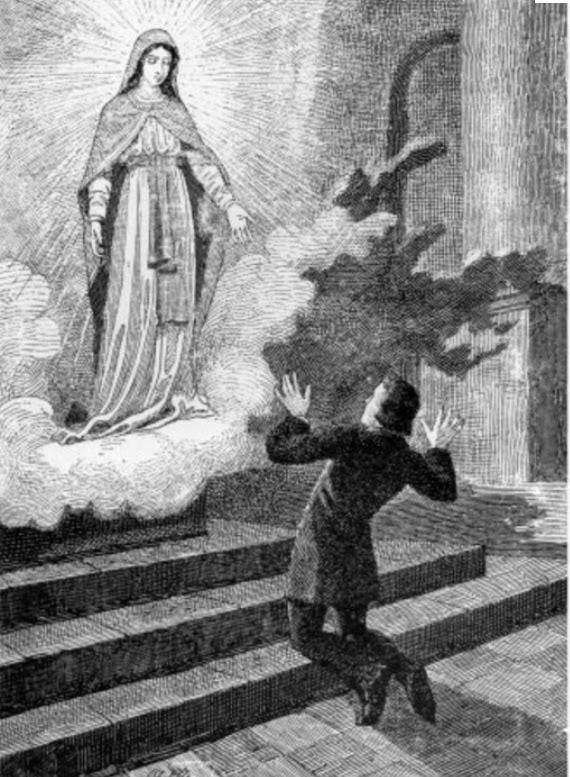
After Our Lady appeared for the last time, Catherine tried again to get through to Fr. Aladel but he refused to listen. Catherine received the habit of the Daughters of Charity on January 30, 1831 and went to work at a hospice in a Paris suburb. She continued to ask Fr. Aladel, and after observing Catherine’s normal daily behavior for nearly two years, he finally informed the Archbishop of Paris about Our Lady’s request.
The bishop ordered 20,000 medals to be struck and distributed. The devotion became so popular that more than a million medals were distributed within four years, and that number had risen to over a billion when Catherine passed away.
The Miraculous Medal was not always the Miraculous Medal
When it was first released, the medal was known as the Medal of the Immaculate Conception.
Immediately after the church began distributing the medal, however, there were numerous stories of miracles attributed to it.
Most of the stories involved physical healings. In one example, devotees began a novena for the healing of a child who was unable to walk. On the first day of the novena, they gave him a Medal of the Immaculate Conception to wear, and on that very day he was healed.
Another example involved the deadly cholera epidemic that had been plaguing Paris. Nearly every pupil in one particular class had been wearing one of the medals except for an 8-year-old girl, and she alone was the only one among them who came down with cholera. She was given a medal to wear, and by the next day she was free of the illness and healthy enough to return to school.
As more stories of miracles came forth, the Medal of the Immaculate Conception came to be called the Miraculous Medal, and that title continues to this day.
The Miraculous Medal has led to conversions
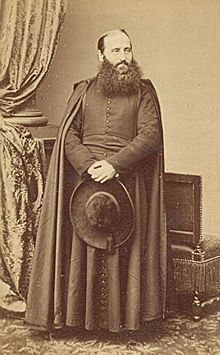
Some of the miracles associated with the Miraculous Medal had more to do with spiritual healings than physical ones.
One of the most famous stories was about a young Jewish man named Alphonse Tobie Ratisbonne, who was very vocal about his deep hatred of Catholicism. In 1841, during a trip to Rome, he met a recent Catholic convert named Baron Bussiers. After Ratisbonne and Bussiers shared a heated debate about Catholicism, Bussiers challenged Ratisbonne to wear a Miraculous Medal and recite the Memorare.
Ratisbonne decided to humor Bussiers. Shortly after wearing the medal and praying as instructed, Ratisbonne experienced a vision of Our Lady exactly as she appeared on the Miraculous Medal. That same night, he converted to Catholicism and got baptized.
Even more amazingly, Alphonse Ratisbonne became a Catholic priest, taking the name of Fr. Alphonse Marie.
Our Lady spoke to St. Catherine nearly all her life
For more than forty years, Catherine worked at a hospice, caring for dying patients.
Although Catherine only experienced three apparitions of Our Lady where she actually saw her, she began experiencing locutions – like an apparition but only as an interior voice – just as Our Lady promised.
When Father Aladel died in 1865, Catherine was left with no one who knew her story and what she had experienced. By May of 1876, sensing that the end of her life was drawing near, Catherine asked Our Lady for permission to share her story, which Our Lady granted.
You can see St. Catherine’s body in Paris
Catherine died on New Year’s Eve – December 31, 1876 – at peace and satisfied that her mission for Our Lady had been completed.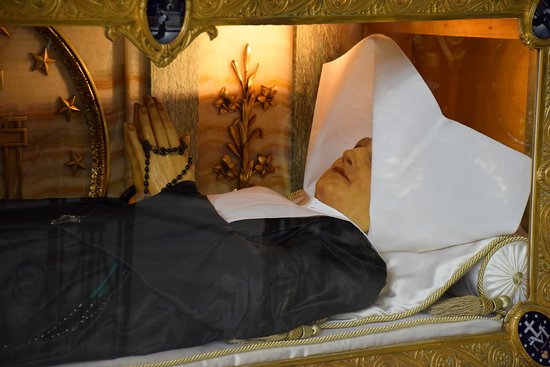
Nearly 60 years after she died, Catherine was beatified on May 28, 1933. When her body was exhumed, it was found to be incorrupt.
Her body now rests in a clear, glass case in the Chapel of Our Lady of the Miraculous Medal, the same place where Mary appeared to her.
On July 27, 1947, St. Catherine Laboure was canonized by Pope Pius XII.
A few years ago, I was blessed to visit Rue Du Bac and pray beside St. Catherine’s incorrupt body. It was fascinating to be so close to her in the chapel where it all began.
St. John Paul II had a devotion to the Miraculous Medal
When John Paul II visited the Chapel of the Miraculous Medal in Parish on May 31, 1980, he recited this prayer: “You watch over the Church for you are its Mother. You watch over each of your Children. From God, you obtain for us, all graces that are symbolized by the rays of light which radiate from your open hands, and the only condition that you demand of us is that we approach with the confidence, the hardiness, and the simplicity of a child. And it is thus that you bring us before your Divine Son.”
Interestingly, Pope John Paul II used a slight variation of the back image of the Miraculous Medal as his coat of arms. The version on his coat of arms features a plain cross with an M in the lower right quadrant of the shield.
St. Catherine was a prophet

According to the book Saints Who Saw Mary by Rafael Brown, Catherine prophesied that all mankind would someday honor Our Lady.
She told her confessor that in the future, the month of Mary would be celebrated throughout the Church with much magnificence.
Catherine said, “Oh how beautiful it will be to hear people say, ‘Mary is Queen of the World!’ She will be honored with banners, and she will go all around the world.”
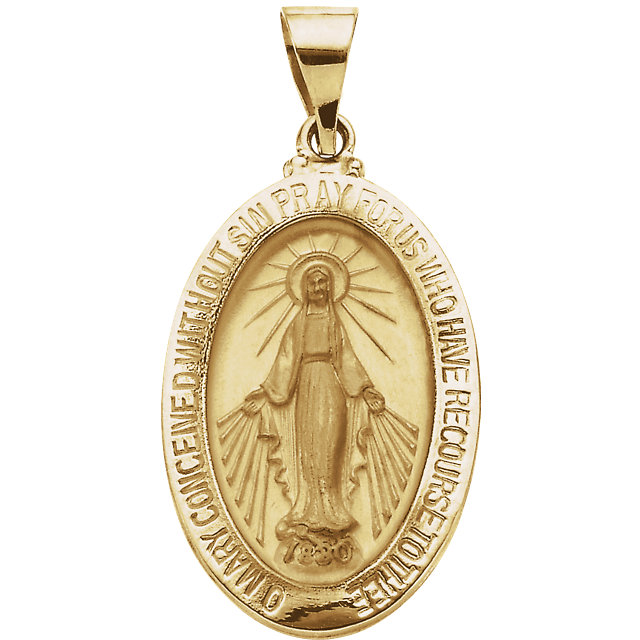 Do you wear a Miraculous Medal? Do your loved ones?
Do you wear a Miraculous Medal? Do your loved ones?
When I founded CatholicShop.com, the very first product I listed – aside from the Marian documentaries I’d produced – was a Miraculous Medal. And I continue to urge everyone to wear one.
CatholicShop.com is currently offering the biggest discounts of the year on Miraculous Medals in hopes that you’ll give them as Christmas gifts to your friends, family members, and even to those who might not seem like they’d ever wear one.
After all, they might surprise you. Just ask my grandfather.
* * * * * * *
Small Sterling Silver Miraculous Medal
40% OFF! Limit: 10 per customer
$59.95
* * * * * * *
24K Gold-plated Miraculous Medal
40% OFF! Limit: 10 per customer
$149.00
* * * * * * *
The Meaning of the Miraculous Medal
from the Association of the Miraculous Medal
The Front
Mary is standing upon a globe, crushing the head of a serpent beneath her foot. She stands upon the globe, as the Queen of Heaven and Earth. Her feet crush the serpent to proclaim Satan and all his followers are helpless before her (Gn 3:15). The year of 1830 on the Miraculous Medal is the year the Blessed Mother gave the design of the Miraculous Medal to Saint Catherine Labouré. The reference to Mary conceived without sin supports the dogma of the Immaculate Conception of Mary—not to be confused with the virgin birth of Jesus, and referring to Mary’s sinlessness, “full of grace” and “blessed among women” (Luke 1:28)—that was proclaimed 24 years later in 1854.
The Back the Medal
The twelve stars can refer to the Apostles, who represent the entire Church as it surrounds Mary. They also recall the vision of Saint John, writer of the Book of Revelation (12:1), in which “a great sign appeared in heaven, a woman clothed with the sun, and the moon under her feet, and on her head a crown of 12 stars.” The cross can symbolize Christ and our redemption, with the bar under the cross a sign of the earth. The “M” stands for Mary, and the interleaving of her initial and the cross shows Mary’s close involvement with Jesus and our world. In this, we see Mary’s part in our salvation and her role as mother of the Church. The two hearts represent the love of Jesus and Mary for us. (See also Lk 2:35).
[Heateor-SC]

